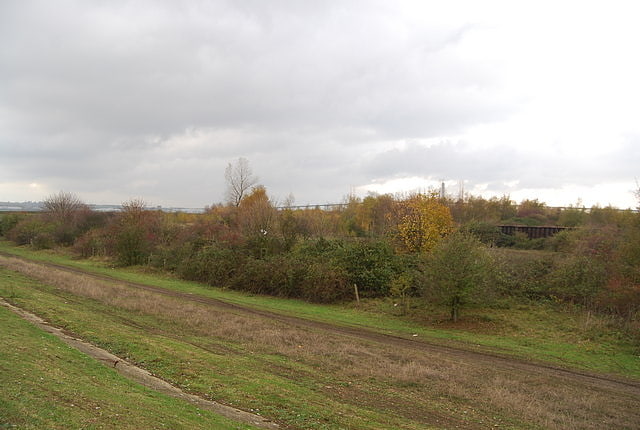Discover 4 hidden attractions, cool sights, and unusual things to do in Purfleet (United Kingdom). Don't miss out on these must-see attractions: High House, Purfleet Chalk Pits, and West Thurrock Lagoon and Marshes. Also, be sure to include Dartford Crossing in your itinerary.
Below, you can find the list of the most amazing places you should visit in Purfleet (England).
Table of Contents
High House

High House is the collective name for a group of historic buildings in Purfleet, Thurrock, Essex, which was used as a farm for hundreds of years, with a Grade II listed house and barn, but with the addition of one of the best dovecotes in Southern England, which is a Scheduled Ancient Monument and notable for its nest box array. This property includes the house, coachman's cottage, chaise house, stable, granary, barn, workshop, cart sheds, dovecote, and inner and outer walled gardens. Known by many names in its past, the farm has been called Le Vineyards, because grape vines were grown on one of its south facing slopes. Its current name comes from the fact that it is a house high on the hill, which commands great views over the River Thames.[1]
Purfleet Chalk Pits

Quarry. Purfleet Chalk Pits is a 10.7 hectare geological Site of Special Scientific Interest in Purfleet in Essex. It is a Geological Conservation Review site.
The chalk pits expose sands and gravels which are associated with the ancient course of the River Thames. They have yielded varied animal, mollusc and plants remains which throw light on the environmental and fluvial conditions at the time when they were deposited. The site is over 280,000 years old, and laid down when this section of the Thames was flowing westwards. There also broken flints in several layers, showing occupation by early humans at several different periods. MIS9, between about 335,000 and 280,000 years ago, is often informally called the Purfleet interglacial, and the mammalian assemblage on the site is the type for the Purfleet Mammalian assemblage zone.
The site consists of Greenlands Quarry, Bluelands Quarry, Botany Pit and Esso Pit. Most of it has been filled in and is covered by a housing estate. A section of Greenlands Quarry has been created for research, but this is closed to the public.[2]
West Thurrock Lagoon and Marshes

West Thurrock Lagoon and Marshes is a 66.1 hectare biological Site of Special Scientific Interest in West Thurrock in Essex.
The site is important for wintering waders and wildfowl which feed on the mudflats. Reed warblers, sedge warblers and bearded tits breed on reed beds in the lagoon, and teals and grey herons roost on the shallow waters and grassy islands. Stone Ness saltings is a large area of salt marsh dominated by sea club-rush. The conservation charity Buglife fought to prevent development of the site, and succeeded in 2014.
The Thames Estuary Path goes through West Thurrock Marshes.[3]
Dartford Crossing

Bridge in the United Kingdom. The Dartford-Thurrock River Crossing, commonly known as the Dartford Crossing and until 1991 the Dartford Tunnel, is a major road crossing of the River Thames in England, carrying the A282 road between Dartford in Kent in the south and Thurrock in Essex in the north. It consists of two bored tunnels and the cable-stayed Queen Elizabeth II Bridge. The only fixed road crossing of the Thames east of Greater London, it is the busiest estuarial crossing in the United Kingdom, with an average daily use of over 130,000 vehicles. It opened in stages: the west tunnel in 1963, the east tunnel in 1980 and the bridge in 1991. The crossing, although not officially designated a motorway, is considered part of the M25 motorway's route, using the tunnels northbound and bridge southbound. Described as one of the most important road crossings in Britain, it suffers from heavy traffic and congestion.
The crossing's development started in the late 1930s, but was interrupted due to the Second World War and resumed in the 1950s. The original tunnel catered for a single lane of traffic in each direction, but rising traffic levels required the second tunnel to be built. The M25 connected to the tunnels at both ends when completed in 1986, and this increased traffic put pressure on the tunnels' capacity. A Private Finance Initiative scheme was started in 1988 to build the bridge. The combined crossing now handles four lanes of traffic in each direction.
The crossing has always been tolled, and though the cost of construction has since been paid back, the toll was retained, and rebranded as a congestion pricing scheme from 1 April 2003. Since 2008 it has been free from 10 pm to 6 am. An automatic number plate recognition charging scheme named the "Dart Charge" began in November 2014. As a result, the booths on the Kent side were removed and the charge is now only payable online, by post, or in certain participating retail outlets. A residents' scheme is available, offering discounts for people living near the crossing.[4]